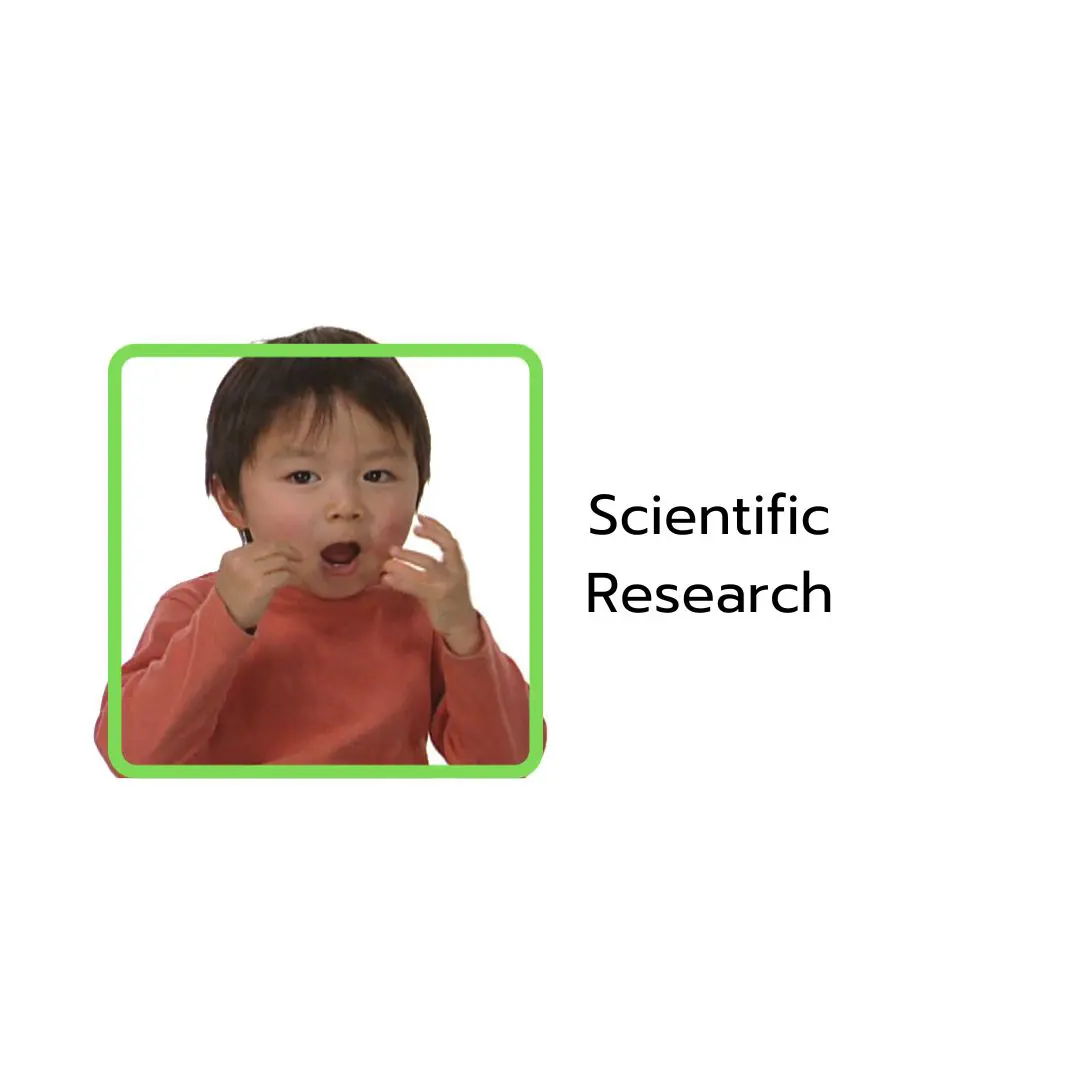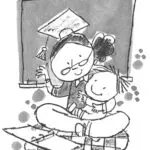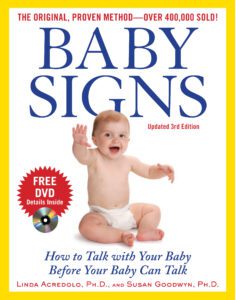
The Baby Signs® Program: A Movement Built on a Solid Foundation
Linda Acredolo, Ph.D. ,Professor Emeritus, UC Davis
Susan Goodwyn, Ph.D. Professor Emeritus, CSU Stanislaus

Why Sign Language for Babies? There’s nothing more heart-wrenching than hearing a baby cry and not knowing why. The problem for babies is with the painstakingly slow development of the ability to produce words. Fortunately, babies are a good deal more adept at controlling the movement of other parts of their bodies. And now, thanks to our two decades of research at UC Davis, babies are enjoying the benefits of using simple signs to let us know what’s on their minds.
The Original Book. Even 11 years after publication, our Baby Signs book continues to be a best-seller. For example, a check of Amazon.com on 3/31/07 found the book at #39 among all parenting books, and at #7 among parenting books focused on infants.
The Movement. Although our research began in 1982, the public was first introduced to the Baby Signs® Program in 1996 via our book, Baby Signs: How to Talk with Your Baby Before Your Baby Can Talk. The book sparked a grassroots movement fueled by word of mouth as more and more families discovered for themselves how easy signing with babies is and how many benefits it yields. Now in its second edition, the book has sold over 500,000 copies, has been translated into 14 languages, and has launched a baby sign language movement that is sweeping the world. Below are some indications that the momentum is continuing to grow.

Signing in Child Care. Signing with babies is growing in popularity among directors of child care programs. To service this trend, the Baby Signs® Program has developed an Early Childhood Educator Curriculum to help large and small child care providers incorporate signing into their classrooms. We have work with programs like Bright Horizons and Mini-Skools, two major child care corporations, to help them add the Baby Signs® Program to their curricula.
Department of Defense. Recognizing the importance of signing to healthy development, the US Department of Defense contracted with Baby Signs® to help implement the Baby Signs® Program in every child care facility on every military base around the world—including all branches of the military (Army, Air Force, Navy and Marines). Read more…
Research. One reason that the Baby Signs® Program has been so well-received is because it is so firmly grounded in research. Below is a summary of the major research findings from our UC Davis research, as well as from research conducted by Dr. Claire Vallotton, a former UCD graduate student, now an Associate Professor of Human Development & Family Studies, MSU and winner of a young investigator award from the World Association for Infant Mental Health (WAIMH).
Results from our NIH-funded study (1989-1998)
Faster Verbal Development. Babies who had been in the Baby Signs® Program developed both receptive and productive verbal skills faster than those who had not. (Journal of Nonverbal Behavior, 2000)
Higher IQs. Retested at age 8, the children in our NIH-funded study who been in the Baby Signs® Program as babies scored significantly higher (by 12 points) on IQ tests than children who had not. (International Conference on Infant Studies, Paris, 2000)
Emotional Benefits. A content analysis of parent interviews indicated that signing was associated with lower frustration, greater respect for babies’ abilities, enriched parent-child relationships, increased interest in books, and enhanced infant self-esteem (Acredolo & Goodwyn, 1996).
Results from Early Head Start (EHS) Intervention Study
EHS families who were encouraged to sign with their children were compared to EHS families who were not in an intervention study in the Yolo County (California) Early Head Start Program conducted by Dr. Vallotton. Results indicated that mothers in the signing families perceived their children as more “reinforcing” and “acceptable,” two important components of a Parenting Stress Index. Why these changes in attitude toward their children? Other results provide clues: Using signs changed the mother-child interactions specifically by (a) helping mothers become more “tuned in” to their children’s emotions, (b) increasing the children’s attempts to communicate with their mothers, and (c) decreasing the number of expressions of distress from the children. These results suggest that the addition of signing to EHS curricula for parents is an easy and effective way to improve family interactions in “at-risk” families. (Paper presented at WAIMH Congress, 2006)
Results from UC Davis Child Care Studies
The Baby Signs® Program has been an integral part of the curriculum at the UCD Center for Child & Family Studies since 1990. Using this setting, Dr. Claire Vallotton conducted a study of 10 infants videotaped in interactions with teachers over an 8-month period and a study of 12 toddlers videotaped in interactions with teachers over a 3-month period. The videotapes were coded to provide data relevant to a variety of specific questions. The following were among the results:
Generally Observed Benefits: Signing in the classroom reduces aggression, builds trust between babies and teachers, provides a “universal language” that facilitates interactions in multi-lingual classrooms, makes teachers more observant and responsive, increases “active” learning, helps daily routines proceed more smoothly. (Paper presented at the Zero to Three 18th National Training Institute, 2003)
Teacher Responsiveness: Using multiple-regression analyses to account for teachers’ experience, children’s age, individual child effects, and frequency of children’s gestures, the data revealed that the children’s use of signs in response to teachers’ signs predicted more responsiveness from caregivers. (Paper presented at WAIMH Congress, 2006)
Internal States: Infants and toddlers used signs to express both emotions (e.g., happy, sad, afraid, mad) and feelings (e.g., sleepy, cold, hurt)—both to label their own states and to comment on the states of other children. Such early evidence of empathy is exciting. (Infant Mental Health Journal).
Conversations: Two-sign combinations were observed as early as 9 months, 3-sign combinations at 12 months. Also, the children routinely used signs to engage in multi-utterance conversations with teachers, with the longest exchange including 16 turns (back and forth) in a conversation about a mom’s departure and eventual return. Paper presented at the International Society for Gesture Studies, June 2007.)
Conclusion
Because the Baby Signs® Program is grounded in research, is so easy to implement, and has so many proven advantages for babies, families, and child care providers, we are confident that the current movement is going to keep on growing until it becomes as accepted and common place for future generations as teaching babies to wave “bye-bye” is today.
The Baby Signs® Program: Two Decades of Scientific Research
Dr. Linda Acredolo and Dr. Susan Goodwyn, the authors of the book Baby Signs: How to Talk with Your Baby Before Your Baby Can Talk have conducted over two decades of academic research on the use of signs with hearing babies, including a long-term study funded by the National Institutes of Health. Their ground -breaking research describes the proven benefits of the Baby Signs® Program.
For those interested in reading more about the background research concerning the Baby Signs® Program (known in scholarly journals as “symbolic gesturing”), the following articles are recommended.
Goodwyn, S.W., Acredolo, L.P. & Brown, C.A. Impact of Symbolic Gesturing on Early Language Development. Journal of Nonverbal Behavior 24, 81–103 (2000).
Acredolo, Linda, and Susan Goodwyn. “The long-term impact of symbolic gesturing during infancy on IQ at age 8.” Ponencia presentada en Meetings of the International Society for Infant Studies, Brighton, UK, 2000.
Brie Moore, Linda Acredolo, & Susan Goodwyn (April 2001). Symbolic gesturing and joint attention: Partners in facilitating verbal development. Paper presented at the Biennial Meetings of the Society for Research in Child Development.
The following articles are part of the complete Baby Signs® Bibliography
Acredolo, Linda P., and Susan W. Goodwyn. “Symbolic gesturing in language development: A case study.” Human development 28.1 (1985): 40-49.
Linda Acredolo and Susan Goodwyn (1990). The significance of symbolic gesturing for understanding language development. In R. Vasta (Ed.), Annals of Child Development (Vol. 7, pp. 1-42). London: Jessica Kingsley Publishers.
Goodwyn, Susan W., and Linda P. Acredolo. “Symbolic gesture versus word: Is there a modality advantage for onset of symbol use?.” Child Development 64.3 (1993): 688-701.
Acredolo, Linda, and Susan Goodwyn. “Furthering our understanding of what humans understand.” Human Development 40.1 (1997): 25-31.
Goodwyn, Susan W., and Linda P. Acredolo. “Encouraging symbolic gestures: a new perspective on the relationship between gesture and speech.” New Directions for Child Development 79 (1998): 61-73.
Acredolo, Linda P., et al. “The signs and sounds of early language development.” Child psychology: A handbook of contemporary issues (1999): 116-139.
Acredolo, Linda, and Susan Goodwyn. “Symbolic gesturing in normal infants.” Child development (1988): 450-466.
Acredolo, Linda, and Susan Goodwyn. “Symbolic gestures in the service of infant-initiated “joint attention”.” Infant Behavior and Development 21 (1998): 62.
Acredolo, Linda P., and Susan W. Goodwyn. “Sign language among hearing infants: The spontaneous development of symbolic gestures.” From gesture to language in hearing and deaf children. Berlin, Heidelberg: Springer Berlin Heidelberg, 1990. 68-78.
Namy, Laura L., Linda Acredolo, and Susan Goodwyn. “Verbal labels and gestural routines in parental communication with young children.” Journal of Nonverbal Behavior 24 (2000): 63-79.
Vallotton, Claire Deanne. Effects of symbolic gestures as a caregiving tool: Children’s social and language development and mothers’ perceptions and behavior. University of California, Davis, 2004.
Vallotton, Claire. “Infants take self-regulation into their own hands.” Zero to Three 29.1 (2008): 29-34.
Vallotton, Claire D., et al. “Quantity and Quality of Gestural Input: Caregivers’ Sensitivity Predicts Caregiver–Infant Bidirectional Communication Through Gestures.” Infancy 22.1 (2017): 56-77.
Vallotton, Claire D. “Infant signs as intervention? Promoting symbolic gestures for preverbal children in low-income families supports responsive parent–child relationships.” Early Childhood Research Quarterly 27.3 (2012): 401-415.
Karsten, Ashley E., et al. “Toddlers take emotion regulation into their own hands with infant signs.” YC Young Children 72.1 (2017): 38-43.
Vallotton, Claire D. “Listening to Preverbal Children: Symbolic Gestures as an Intervention to Enhance the Caregiver-Child Relationship“
Vallotton, Claire D. “Do infants influence their quality of care? Infants’ communicative gestures predict caregivers’ responsiveness.” Infant Behavior and Development 32.4 (2009): 351-365.
Vallotton, Claire D. “Signs of emotion: What can preverbal children “say” about internal states?.” Infant Mental Health Journal: Official Publication of The World Association for Infant Mental Health 29.3 (2008): 234-258.
Vallotton, Claire. “Babies open our minds to their minds: How “listening” to infant signs complements and extends our knowledge of infants and their development.” Infant Mental Health Journal 32.1 (2011): 115-133.
Vallotton, Claire D., and Catherine C. Ayoub. “Symbols build communication and thought: The role of gestures and words in the development of engagement skills and social‐emotional concepts during toddlerhood.” Social development 19.3 (2010): 601-626.
Vallotton, Claire D. “Infant signs as intervention? Promoting symbolic gestures for preverbal children in low-income families supports responsive parent–child relationships.” Early Childhood Research Quarterly 27.3 (2012): 401-415.
Vallotton, Claire D. “Do infants influence their quality of care? Infants’ communicative gestures predict caregivers’ responsiveness.” Infant Behavior and Development 32.4 (2009): 351-365.
Vallotton, Claire D. “Sentences and conversations before speech? Gestures of preverbal children reveal cognitive.” Integrating gestures: The interdisciplinary nature of gesture 4 (2011): 105.
Vallotton, Claire, et al. “Give me a hand: Differential effects of gesture type in guiding young children’s problem-solving.” Instructional science 43 (2015): 709-735.
Wang, Wen, and Claire Vallotton. “Cultural transmission through infant signs: Objects and actions in US and Taiwan.” Infant Behavior and Development 44 (2016): 98-109.
Konishi, Haruka, Ashley Karsten, and Claire D. Vallotton. “TODDLERS’USE OF GESTURE AND SPEECH IN SERVICE OF EMOTION REGULATION DURING DISTRESSING ROUTINES.” Infant Mental Health Journal 39.6 (2018): 730-750.
Paul, Ian M., et al. “Exploring infant signing to enhance responsive parenting: Findings from the INSIGHT study.” Maternal & child nutrition 15.3 (2019): e12800.
Vallotton, Claire. “Signing with Babies and Children.” Commissioned by: Two little Hand Productions (2011).

